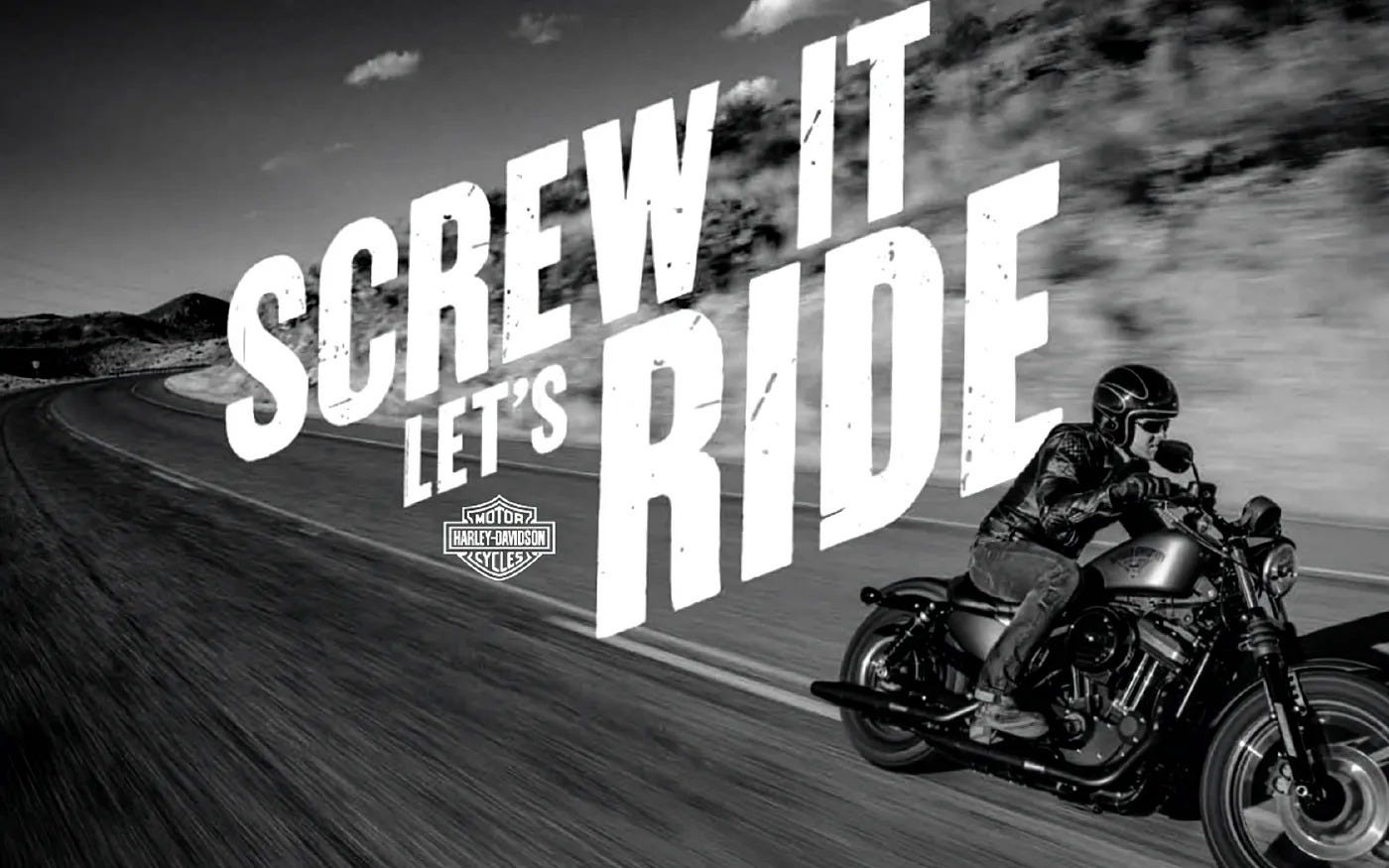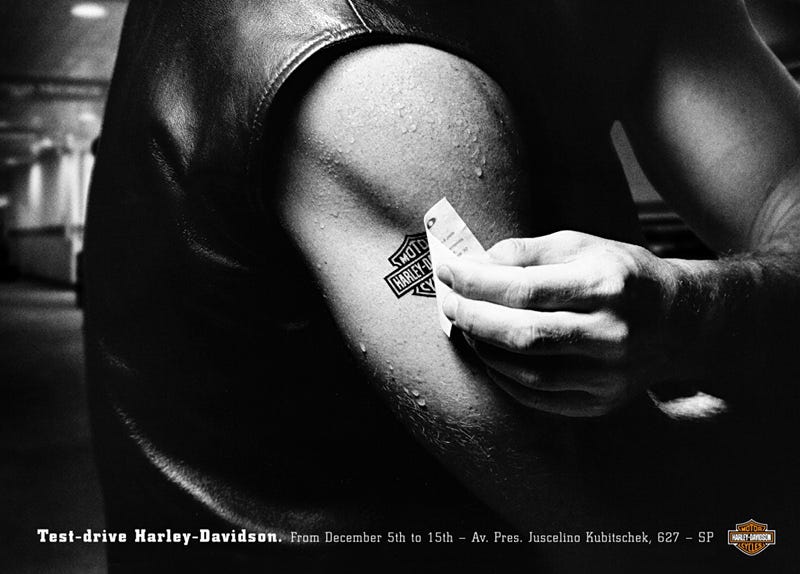The Brand with One of the Strongest Communities in the World
Another story that proves that community of die hard fans is the brand's superpower.
By now you probably already know how much I respect brands with strong communities. I truly believe that a genuine community of die hard fans is the brand's superpower. I also know that building that community is extremely hard and very few are able to nail it.
So today it’s gonna be a story of a brand that has a big army of die-hard fans standing next to them. Extremely loyal community whose retention is a lifetime! Fans who are so certain about their commitment that they get the brand's tattoo on their skin!
But that’s now…And it’s not always been the case.
No wonder. The brand has a 120 years history after all.
Did you already guess the brand?
Today I will be writing about the one and only - Harley Davidson.
Early days
It took 2 brothers (Arthur and Walter Davidson), a friend (William Harley), a shed and an idea to give birth to Harley Davidson’s first prototype in 1903. The initial business idea was to attach an engine to a standard motorcycle.
The first Harley-Davidson factory was built in 1906 in Milwaukee (50 bikes produced that year) and the company was officially incorporated in 1907.
1903 Harley-Davidson | Serial Number 1
By 1914 USPS was delivering mail with 4,800 Harley Davidson bikes. Later the military was using those bikes. After that in the 1950s police departments used those too.
Let’s fast forward to the late 1960s when the company went almost bankrupt and AMF (American Machine and Foundry) bought it. Those years seem to have been the worst period for the brand.
AMF was manufacturing bowling equipment, tennis rackets, and snow skis before acquiring Harley Davidsson so it lacked the knowledge and expertise for the turnaround. As a result of their severe cost cutting the quality fell a lot, damaging the brand's reputation.
During the same time foreign motorcycles such as Yamaya and Honda came to the market with better quality and lower price tags and became very popular. Outlaw biker gangs riding Harley-Davidsons did not help the brand’s image either.
Harley kept losing market share and it was really tough!
The Buyback
After 12 years of ownership, in 1981, a group of 13 investors bought back Harley Davidson from AMF for $80 million. One of those investors (Willie G. Davidson), was one of the cofounder’s grandsons.
At that point they got a company with a damaged reputation, decreasing sales and low morale among employees. But unlike AMF, new owners were dedicated to turning things around. So they rolled up their sleeves and got to work.
In order to change things they needed a complete restructuring, revisiting the processes and reevaluating everything. They needed a full restart.
So what did they do?
The comeback
To address the quality of their bikes they outsourced many parts from foreign manufacturers. Eventually they started building high-quality bikes again.
Then they turned their gaze to the competitors. Instead of trying to fit in and produce bikes similar to those that Japanese brands brought, they decided to stay true to themselves, go back to their roots and focus on motorcycles that looked like their pre-AMF older models.
They decided to completely change their competitive and business strategies and bet on the brand community philosophy. Their community strategy became the core of everything.
I guess back then they already realised that in theory everything can be copied: models, engineering innovative idea, strategies, etc - but one thing that can’t be copied and taken away from a brand is its community.
And it worked!
As a result Harley Davidson became a brand that was beyond just bikes. It became an icon of something way more important. They managed to create an extremely strong connection between their brand and its community.
But how?
Community efforts bring best results when they are not ONLY a marketing function. In this case the whole company on a strategic level was committed to building a community and marketing worked hard on shaping a community centric brand.
They launched HOG (Harley Owner’s Group) in 1983 so they could know their customers and build long-lasting relationships with them.
More than motorcycles
I imagine them getting together and going back to the most important basic question: why do they do what they do? What are they about? What’s their mission?
Let’s check their official mission statement. Here is the most important part of it below:
“Our mission: More than building machines, we stand for the timeless pursuit of adventure. Freedom for the soul. Our ambition is to maintain our place as the most desirable motorcycle brand in the world.”
They positioned themselves being about things that are way bigger than just bikes.
“Harley is not automotive. It might have an engine, it might have wheels, and it might run on roads, but that’s where the similarities stop.”
-Mark Hans Richer, Former CMO Harley-Davidson Motor Company
Harley Davidsson’s impressive marketing was able to re-defined brand loyalty and achieved a cult brand status. They crafted a brand that’s built on customer loyalty, innovation, and emotions (the strong ones!).
They promote not just a consumer product but a lifestyle and passion.
In people’s mind Harley Davidson is about one of the strongest desires: freedom.
Freedom from mainstream values and status quo. Freedom to travel anywhere you want, whenever you want. Freedom of spirit!
Harley gives people the freedom to experience an open world.
The logo of the eagle and biker clothing supports the trait.
Harley Davidson is also about individualism.
You can be yourself no matter who you are. Everyone is equal in the community: no matter what’s your status, income, job, race, etc. The “brotherhood” of riders is united by a shared ethos and the passion of the Harley Davidson lifestyle.
They share the road, the wind and the free spirit!
Who shapes who though?
I would argue that in the community building effort there comes a point when you see an important shift and that’s when you realise that you made it - it worked.
The shift is when you realise that the community is the one now shaping and leading the brand. When they become the heroes of the story at the epicenter of everything and choosing the direction.
IT’S NOT ABOUT THE BRAND itself but rather the PEOPLE around the brand!
“People don’t fall in love with products or brands – they fall in love with the people that surround those products and brands, people who let them talk about themselves and feel a sense of belonging.
-Ken Schmidt, the former director of communications for Harley Davidson
And how do you put a price tag next to something so emotional?
Well, apparently it’s worth a lot to people. And here is why creating that emotional connection and building a genuine community is so important for a brand.
“If we were rational, logical people, you’d always go with the Honda,” said Ken. “But we’re not. You’ll go with the way more expensive Harley. You could buy three Hondas for the price of one Harley.”
Why? Because of the community. You can’t buy community or transfer community – for better or worse, it’s permanently attached to a product or brand. And since that’s the case, it’s best to embrace your community and ensure it remains vibrant and authentic.
- Ken Schmidt, the former director of communications for Harley Davidson
Aftermath
As of March 2023, there are approximately 1.5 million registered owners of Harley-Davidson motorcycles worldwide.
Most of these people are die-hard fans who have never even been tempted to check out any other bike out there.
Their loyalty is for life!
There are only a few brands that people tattoo the logo on their bodies.
But in Harley’s case it’s so common that they have tattoo salons located inside some of their dealerships!
I don’t have a Harley tattoo myself but I am a huge fan of the brand. Freedom and individualism are among my most important values too. So you can say this brand is my soulmate.
Well, it’s a wrap.
“Meet” you next week with another story.












